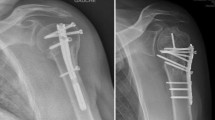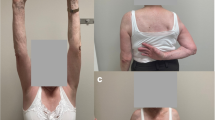Abstract
Introduction
Treatment of humeral shaft fractures by functional bracing has been reported to be effective in achieving high rate of fracture union and good function of the adjacent shoulder and elbow joints. Since our previous clinical impression indicated an occurrence of shoulder function impairment following this treatment, we investigated the shoulder function in a consecutive series of patients treated by functional bracing for fractures of humeral shaft in order to estimate their residual shoulder function.
Materials and methods
We followed 15 consecutive patients with humeral shaft fractures treated by functional brace. The mean follow up was 30 months (range 12–57 months); seven patients with midshaft fracture, four patients with proximal third, and four patients with fractured distal third of the humeral diaphysis. All the patients were evaluated by the Constant score of the injured limb in comparison to the contra-lateral not injured shoulder and by the Oxford shoulder score of the injured limb.
Results
We found that all the fractures were united with mean varus angulation of 13° and with mean angulation in the saggital plane of 9° antecurvatum, Constant scores were significantly lower in the injured shoulders (P < 0.001) and the function of the shoulders in the injured extremities were estimated as having mean Oxford shoulder score of 34 (range 17–54).
Conclusions
The evaluation of the present series revealed an impaired functional outcome in the shoulders after humeral shaft fracture. Our results indicate that although the fracture union is usually achieved following the functional bracing of humeral shaft fractures, the shoulder function in the injured limb may remain impaired.


Similar content being viewed by others
References
Charnley J (1999) Fractures of the shaft of the humerus. The closed treatment of common fractures, 4rth edn. Colt Books Ltd, Cambridge, pp 99–104
Constant CR, Murley AHG (1985) A clinical method of functional assessment of the shoulder. Clin Orthop 214:160–164
Dawson J, Fitzpatrick R, Carr A (1996) Questionnaire on the perceptions of patients about shoulder surgery. J Bone Joint Surg 78(4):593–600
Fjalestad T, Stromsoe K, Salvesen P, Rostad B (2000) Functional results of braced humeral diaphyseal fractures: why do 38% lose external rotation of the shoulder. Arch Orthop Trauma Surg 129:281–285
Koch PP, Gross DFL, Gerber C (2002) The results of functional (Sarmiento) bracing of humeral shaft fractures. J Shoulder Elbow Surg 11(2):143–150
Murphy WM, Leu D (2000) Fracture classification: biological significance. In: Rüedi TP, Murphy WM (eds) AO principles of fracture management. Thieme, Stuttgart, pp 45–53
Pahlivan O (2002) Functional treatment of the distal third humeral shaft fractures. Arch Orthop Trauma Surg 122:390–395
Robinson CM, Bell KM, Court Brown CM, McQueen MM (1992) Locked nailing of humeral shaft fractures. Experience in Edinburgh over a two-year period. J Bone Joint Surg 74(B):558–562
Sarmiento A, Zagorski JB, Zych GA, Latta LL, Caps CA (2000) Functional bracing for the treatment of fractures of the humeral diaphysis. J Bone Joint Surg 82(A):478–486
Wallny T, Sagebiel C, Westerman K, Wagner UA, Reimer M (1997) Comparative results of bracing and interlocking nailing in the treatment of humeral shaft fractures. Int Orthop 21:374–379
Author information
Authors and Affiliations
Corresponding author
Rights and permissions
About this article
Cite this article
Rosenberg, N., Soudry, M. Shoulder impairment following treatment of diaphysial fractures of humerus by functional brace. Arch Orthop Trauma Surg 126, 437–440 (2006). https://doi.org/10.1007/s00402-006-0167-9
Received:
Published:
Issue Date:
DOI: https://doi.org/10.1007/s00402-006-0167-9




